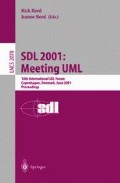Abstract
A set of scenarios is a useful way to capture many aspects of the requirements of a system. Use Case Maps are a method for scenario capture which is good for describing multiple scenarios, including scenario interactions, for developingan architecture, and for analysing architectural alternatives. However, once a component architecture is determined, Message Sequence Charts are better for developing and presentingthe details of interactions, and provide access to well-developed methodologies and tools for analysis and synthesis. This paper considers what must be specified in UCM scenarios and the architecture to make it possible to derive MSCs automatically, and it describes our experience in executingthese transformations within a prototype tool, the UCM Navigator.
This research was supported by Nortel Networks, Mitel Networks, and by the Industrial Partnerships program of the Natural Sciences and Engineering Research Council of Canada. Discussions with John Visser, Jim Hodges, Jacques Sincennes, Luigi Logrippo and Gunter Mussbacher were helpful in developing the ideas.
Access this chapter
Tax calculation will be finalised at checkout
Purchases are for personal use only
Preview
Unable to display preview. Download preview PDF.
References
Abdalla, M.M., Khendek, F. and Butler, G.: “New Results on DerivingSDL Specifications from MSCs”. In: SDL’99, Proceedings of the Ninth SDL Forum, Montreal, Canada. Elsevier (1999)
Amyot, D. and Andrade, R.: “Description of Wireless Intelligent Network Services with Use Case Maps”. In: SBRC’99, 17○ Simpósio Brasileiro de Redes de Computadores, Salvador, Brazil (May 1999) 418–433
Amyot, D. and Logrippo, L.: “Use Case Maps and Lotos for the Prototypingand Validation of a Mobile Group Call System”. In: Computer Communication, 23(12) (May 2000) 1135–1157
Amyot, D. and Mussbacher, G.: “On the Extension of UML with Use Case Maps Concepts”. In: ≪UML≫2000, 3rd International Conference on the Unified Modeling Language, York, UK (October 2000), LNCS 1939, 16–31
Amyot, D.: “Use Case Maps as a Feature Description Language”. In: S. Gilmore and M. Ryan (Eds), Language Constructs for Designing Features. Springer-Verlag (2000) 27–44
Amyot, D. and Eberlein, A.: “An Evaluation of Scenario Notations for Telecommunication Systems Development”. In: 9th Int. Conference on Telecommunication Systems (9ICTS), Dallas, USA (March 2001)
Andrade, R.: “ApplyingUse Case Maps and Formal Methods to the Development of Wireless Mobile ATM Networks”. In: Lfm2000: The Fifth NASA Langley Formal Methods Workshop, Williamsburg, Virginia, USA (June 2000)
Bordeleau, F.: A Systematic and Traceable Progression from Scenario Models to Communicating Hierarchical Finite State Machines. Ph.D. thesis, School of Computer Science, Carleton University, Ottawa, Canada (August 1999)
Bordeleau, F. and Cameron, D.: “On the Relationship between Use Case Maps and Message Sequence Charts”. In: 2nd Workshop of the SDL Forum Society on SDL and MSC (SAM2000), Grenoble, France (June 2000)
Bos, M. and Mauw, S.: “A LATEX macro package for drawing Message Sequence Charts”. Version 1.47, http://www.win.tue.nl/~sjouke/mscpackage.html (1999)
Buhr, R. J. A. and Casselman, R. S.: Use Case Maps for Object-Oriented Systems, Prentice-Hall (1996)
Buhr, R. J. A.: “Use Case Maps as Architectural Entities for Complex Systems”. In: IEEE Transactions on Software Engineering, 24(12) (Dec. 1998) 1131–1155
Cameron, D. et al.: Draft Specification of the User Requirements Notation. Canadian contribution CAN COM 10-12 to ITU-T, Geneva (November2000)
Chung, L., Nixon, B. A., Yu, E. and Mylopoulos, J.: Non-Functional Requirements in Software Engineering. Kluwer Academic Publishers (2000)
Elammari, M. and Lalonde, W. (1999) “An Agent-Oriented Methodology: High-Level and Intermediate Models”. In: Proc. of the 1st Int. Workshop. on Agent-Oriented Information Systems (AOIS’99), Heidelberg, Germany (June 1999)
Hodges, J. and Visser, J.: “Accelerating Wireless Intelligent Network Standards Through Formal Techniques”. In: IEEE 1999 Vehicular Technology Conference (VTC’99), Houston (TX), USA (1999)
ITU-T: Recommendation I.130, Method for the characterization of telecommunication services supported by an ISDN and network capabilities of ISDN. CCITT, Geneva (1988)
ITU-T: Recommendation Z.100, Specification and Description Language (SDL). Geneva (1999)
ITU-T: Recommendation Z.120, Message Sequence Chart (MSC). Geneva (1999)
ITU-T: Recommendation Q.65, The unified functional methodology for the characterization of services and network capabilities including alternative object-oriented techniques. Geneva (2001)
Miga, A.: Application of Use Case Maps to System Design with Tool Support. M.Eng. thesis, Dept. of Systems and Computer Engineering, Carleton University, Ottawa, Canada (October 1998)
Mansurov, N. and Zhukov, D.: “Automatic synthesis of SDL models in use case methodology”. In: SDL’99, Proceedings of the Ninth SDL Forum, Montreal, Canada. Elsevier (1999)
Sales, I. and Probert, R. L.: “From High-Level Behaviour to High-Level Design: Use Case Maps to Specification and Description Language”. In: SBRC’2000, 18○ Simpósio Brasileiro de Redes de Computadores, Belo Horizonte, Brazil (May 2000)
Scratchley, W. C.: Evaluation and Diagnosis of Concurrency Architectures. Ph.D. thesis, Dept. of Systems and Computer Engineering, Carleton University, Ottawa, Canada (November 2000)
Use Case Maps Web Page and UCM User Group (since March 1999) http://www.UseCaseMaps.org
Yi, Z.: CNAP Specification and Validation: A Design Methodology Using Lotos and UCM. M.Sc. thesis, SITE, University of Ottawa, Canada (2000)
Weidenhaupt, K., Pohl, K., Jarke, M., and Haumer, P.: “Scenarios in System Development: Current Practice”. In: IEEE Software (March/April 1998) 34–45
Author information
Authors and Affiliations
Editor information
Editors and Affiliations
Rights and permissions
Copyright information
© 2001 Springer-Verlag Berlin Heidelberg
About this paper
Cite this paper
Miga, A., Amyot, D., Bordeleau, F., Cameron, D., Woodside, M. (2001). Deriving Message Sequence Charts from Use Case Maps Scenario Specifications. In: Reed, R., Reed, J. (eds) SDL 2001: Meeting UML. SDL 2001. Lecture Notes in Computer Science, vol 2078. Springer, Berlin, Heidelberg. https://doi.org/10.1007/3-540-48213-X_17
Download citation
DOI: https://doi.org/10.1007/3-540-48213-X_17
Published:
Publisher Name: Springer, Berlin, Heidelberg
Print ISBN: 978-3-540-42281-5
Online ISBN: 978-3-540-48213-0
eBook Packages: Springer Book Archive

